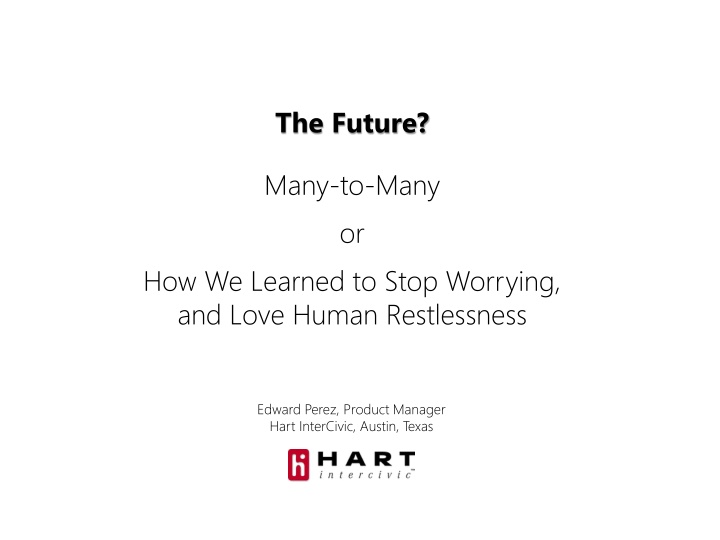Embracing Human Restlessness in the Era of Many-to-Many Connectivity
Exploring the shift towards human-centered design and the rise of many-to-many solutions in technology, this presentation by Edward Perez delves into the concept of the Internet of Things and its potential impact on connectivity. It discusses the importance of adapting to human needs, enhancing usability, and preparing for the dynamic and creative nature of individuals. The future landscape of technology is envisioned as one where participation, devices, and modalities thrive in a connected ecosystem, leading to innovative solutions and opportunities. Additionally, it touches upon utilizing technology for enhancing access and participation in electoral processes through various digital tools and platforms.
Download Presentation

Please find below an Image/Link to download the presentation.
The content on the website is provided AS IS for your information and personal use only. It may not be sold, licensed, or shared on other websites without obtaining consent from the author.If you encounter any issues during the download, it is possible that the publisher has removed the file from their server.
You are allowed to download the files provided on this website for personal or commercial use, subject to the condition that they are used lawfully. All files are the property of their respective owners.
The content on the website is provided AS IS for your information and personal use only. It may not be sold, licensed, or shared on other websites without obtaining consent from the author.
E N D
Presentation Transcript
The Future? Many-to-Many or How We Learned to Stop Worrying, and Love Human Restlessness Edward Perez, Product Manager Hart InterCivic, Austin, Texas
1. the approach focus on the human needs
human-centered design focus on human needs usability, adaptability, transparency assume that humans will be fickle and creative and try to get ready for that
2. the solutions many-to-many
The next logical step in the technological revolution connecting people anytime, anywhere is to connect inanimate objects. This is the vision underlying the Internet of things things: anytime, anywhere, by anyone and anything. the Internet of - International Telecommunication Union, Geneva, 2005
many-to-many more participation, more devices, more modalities
Information Technology & Innovation Foundation Home-based access Use home computers to download & mark ballots Online rating systems for polling places, like Yelp Online voter education profiles for receipt of VEO materials in different formats Online polling place accessibility information Ridesharing to facilitate carpools to voting locations Barcodes to transfer voting choices Drive-thru voting iPad/Tablet voting Smartphone apps, to enable mobile voting from anywhere in the world Remote voting options Portable election kiosks in care facilities (e.g., tablets) Online interactive voters guides Automated deadline reminders via phone, text or email (absentee ballots, Election Day voting) Use familiar technology to vote (phones, ATMs, televisions) Online wait times for polling places Mobile voting vans Online poll worker training
usability adaptability transparency access innovation openness
3. the challenges catching up to the pace of change
Getting the standards in line with innovation Diversity of devices vs. flattening thrust of complex standards Fewer configurations, or many? Getting our laws in line with innovation Laws can either support or restrict new methods of participation Changing outdated/unusable ballot designs Voter access (registration, convenience voting, etc.) Allowing new kinds of technology Right-sizing the technology Competing values access, security, usability, cost, etc.
Recommendations - Technology 1. Certify what s necessary no more, no less. Enlarge & clarify distinction between election management vs. voting system. 2. Facilitate the use of cost-effective transferable technologies. Allow the incorporation of more commercial-off-the-shelf hardware, in a traceable, safe, cost-effective way, without requiring full re- certification. 3. Devise procedures for software modifications. Consider methods to safely and reliably enable incremental changes to be made to certified software applications (i.e. de minimis changes). 4. Leave design to the technologists. Aim for standards that do not over-prescribe specific solutions, which can increase cost and complexity; identify problems to be prevented, rather than specific implementations.
usability adaptability transparency technology by the many, for the many access innovation openness
thank you eperez@hartic.com























